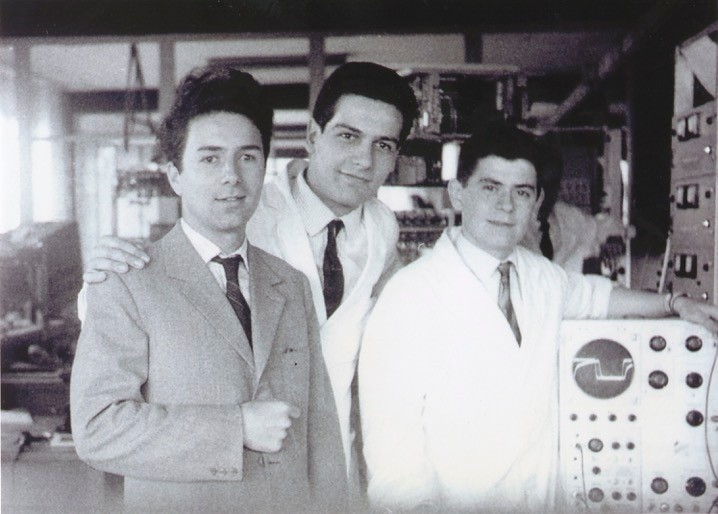THE DEVELOPMENT OF MILITARY TECHNOLOGY AND THE GREAT ECONOMIC FAILURE

In several articles[1] we have described how, starting with the Korean War, but actually already before, the US production system needed the ‘Necessary Enemy’ (not necessarily always the same one) in order to function at full capacity and expand, and, therefore, continuous tensions with other states and wars and warfare in a contained geographical area. Now we see how this state of affairs in the military sector has had huge spill-over effects in the civil sector in various fields, giving rise to what we use to call modernity: from the digital world to the web, from e-mail to so-called social networking, from mobile phones to nuclear power plants that produce electricity.
Civil aircraft industry. In the US, this industry is a direct offspring of what is referred to in the articles as military R&D (Research & Development). Many of the civil aircraft developed after the Second World War are adaptations of the jets used in the bombing raids: the Boeing B-47 was transformed into the Boeing 707 passenger aircraft[2] . The later Boeing 747 came from the design (which remained as such) of the C-5 freighter of the Air Force[3] . Of course, Soviet, and thus Eastern European, civil aviation is also an offspring of military aviation.
Nuclear energy. The certainly most sensational and shocking example of this comes from the two bombings that reduced tens of thousands of lives in Hiroshima and Nagasaki to ashes – and only shadows printed on asphalt. The Manhattan Project[4] saw the birth of the first nuclear reactor, but only because the entire project was aimed at building atomic bombs, both the uranium-based and the plutonium-based type. Historically, civil nuclear power has always been inextricably linked to military nuclear power[5] . Today, the distinction between civil nuclear reactor and military nuclear reactor can be said, polemically, to be so thin that it no longer exists, in fact – because the civil one can become a weapon[6] .
Microelectronics, computer networks, the Internet. In 1969, the Advanced Research Projects Agency (ARPA), the Pentagon’s research agency, launched the ARPAnet computer network to provide engineers and computer scientists working on military projects with the possibility of sharing computing resources[7] . It was in fact the American reaction to the surprise launch of the first artificial satellite by the then existing Soviet Union. A second step in the construction and expansion of the Net came later with the invention of a protocol to exchange messages (E-mail). Renamed the Internet, it had less than 500 computers until 1983. At the same time, the USSR suffered the disadvantages of having to deal with huge military expenditure without being able to enjoy the spill-over of indirect benefits, due to the absence in Soviet society of inter-industrial flows, which existed in market economies.

Silicon Valley: civil engineers in the service of military project development[8]
It should be noted that there would be no mobile phones, personal computers, the Web, Facebook, WhatsApp, so-called social networking, etc., in short, the ‘online modernity’ that has changed the world as a whole, nor would there be the famous Silicon Valley. if the Italian Federico Faggin (born in the province of Vicenza and emigrated to the USA for work) had not invented the silicon-port microprocessor[9] . Bill Gates[10] explicitly recognised this: ‘Without Federico Faggin, Silicon Valley would have remained just the Valley’ . [11]
In this respect, it is serious and symptomatic that Matteo Renzi – at the time head of our government and Secretary of the Democratic Party (PD) – in his famous conference at the Leopolda in October 2014, wanted to model his presidency stage after ‘Steve Jobs’ garage’ – the one where, in Silicon Valley, the colossus that had become Apple emitted its first wailing sounds[12] . The message was clear: a garage to restart ‘automotive Italy’, which had been at a standstill for too long. Certainly, however, wanting to restart it while ignoring Federico Faggin and his garage, actually his small workshop, is rather presumptuous. Pompous and provincial.
The conquest of space. The first to send an artificial satellite, and later also a human being, into orbit were the Soviets: on 4 October 1957 and 12 April 1961 respectively[13] . The subsequent competition with the USA produced not only the first man to land on the moon, the American Neil Armostrong on 20 July ’69, but also the network of artificial satellites that made the planetary spread of mobile phones, computers, and many other innovations in navigation possible.
It is really difficult – if not grotesque – to argue that the military-industrial complex is of a size commensurate with the external threats aimed at the US (really aimed at it by other countries and not as alleged by propaganda). Instead, it is easy to show that its main effect is the negative influence on US foreign policy, because it favours the influence of the military, resembling its continuous militarisation, to the detriment of the use and enhancement of diplomacy.
These characteristics have influenced the economic bleeding of the USSR, until its dissolution, due to the continuous pursuit of rearmament, so as not to fall too far behind the arsenals, not only atomic, of the United States. The US military-industrial complex has thus become the most important federal economic entity, but its aims are both military and domestic political: it guarantees the dissemination of military orders and the resulting employment throughout the federal territory.

September 1965: Federico Faggin (left) presents the world’s first microprocessor, which he created at Olivetti in Ivrea[14]
Since the dissemination takes place not with industrial or financial criteria, but with electoral criteria – i.e. to win votes for candidates in the elections in the areas benefiting from military investments – such dissemination lacks the very economic purposes that would justify it and make it plausible. Ditto for all the other countries engaged in the arms race.
This is the only way to fully understand why certain behaviours, such as Bush son’s incredible refusal to scrap the possibility of signing full peace pacts prepared by North Korea and Secretary of State Magdalene Albright during the Clinton presidency[15] . Without strong politico-military tensions, the military-industrial complex would lose steam. And employment would suffer. With negative electoral effects for the reappointment of presidents and parliamentarians. The same applies to the bad relations with Iran and, on a smaller but not too large scale, Cuba.
To better understand what we are talking about, just think that thanks to their ‘shock and awe’ strategy, the US launched as many as 800 cruise missiles within the first 48 hours of the invasion of Iraq in March 2003[16] . A mass launch aimed more at emptying warehouses of old models – and thus being able to produce new ones – than at hitting useful targets. Moreover, in Iraq between 2002 and 2005, i.e. in just 3-4 years, the US armed forces fired 6 billion bullets: about 200-300 thousand bullets for every person killed[17] . Figures that are simply insane. Useful only to the military industry, or rather to the ‘military-industrial complex’ first named by Eisenhower and about which we have spoken in our articles. Because it is necessary for all of us to have the tools to understand, and not only the tools to blindly believe this or that propaganda.
ITA040
[1] THE BELLIC INDUSTRY PLANS THE THIRD WORLD WAR – THE GENERAL STATEMENTS ; THE BELLIC INDUSTRY PLANS THE THIRD WORLD WAR – The Global Pitch
[2] http://web2.ba.infn.it/nardulli/HIGHTECH.html
[3] https://it.wikipedia.org/wiki/Boeing_747
[4] https://www.focus.it/cultura/storia/le-origini-top-secret-del-progetto-manhattan-bomba-atomica
[5] https://valori.it/ganapini-nucleare-civile-militare-legami/
[6] https://www.ilfoglio.it/piccola-posta/2022/08/19/news/il-nucleare-civile-non-esiste-piu-le-centrali-possono-diventare-armi-4340295/
[7] https://www.fastweb.it/fastweb-plus/digital-magazine/storia-del-progetto-arpanet/
[8] https://warontherocks.com/2019/01/the-rift-between-silicon-valley-and-the-pentagon-is-economic-not-moral/
[9] https://www.historybit.it/federico-faggin/
[10] https://www.repubblica.it/tecnologia/dossier/speciale-itw-2022/2022/09/10/news/faggin_intervista-364947457/
[11] https://it.wikipedia.org/wiki/Silicon_Valley
[12] https://www.macitynet.it/renzi-come-steve-jobs-si-parte-da-un-garage-per-cambiare-il-mondo/
[13] https://www.ansa.it/canale_scienza_tecnica/notizie/spazio_astronomia/2019/07/17/la-corsa-alla-luna-dallo-sputnik-a-bezos-_143d2788-951e-47f6-bc62-5735236b4bd1.html#:~:text=Il%2020%20luglio%201969%20lo,essere%20vivente%2C%20la%20cagnetta%20Laika
[14] https://www.domusweb.it/it/notizie/2021/05/23/federico-faggin-siamo-uomini-le-macchine-non-ci-sostituiranno.html
[15] https://www.glistatigenerali.com/asia_geopolitica/kim-jong-un-e-le-colpe-degli-stati-uniti/
[16] https://pagineesteri.it/2021/10/07/medioriente/inchiesta-malformazioni-congenite-leredita-tossica-della-guerra-americana-in-iraq/
[17] https://pagineesteri.it/2021/10/07/medioriente/inchiesta-malformazioni-congenite-leredita-tossica-della-guerra-americana-in-iraq/




Leave a Reply